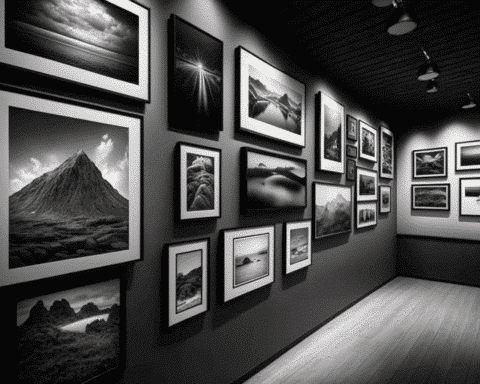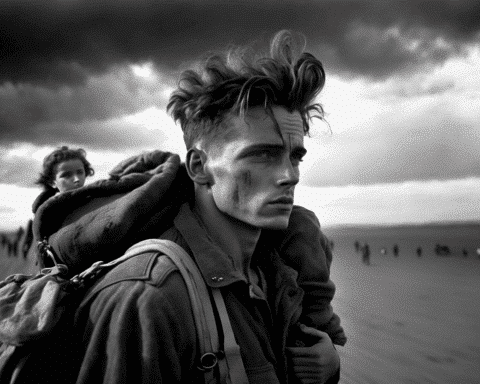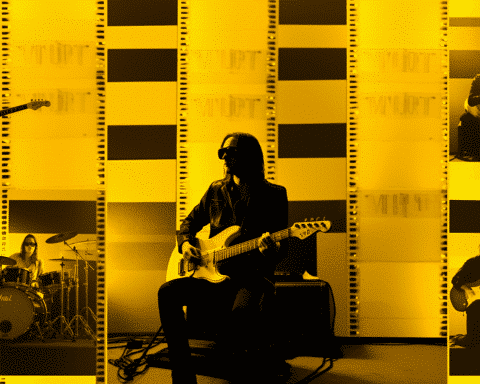British visual artist Reuben Wu, based in Chicago, is known for his sublime imagery of remote landscapes using drone lighting.
He enhances craggy peaks with halos and writes glyphs in the sky like signals from a supernatural entity.
Wu started his photography as a hobby while focusing on a music career as one of the four members of the synth-pop band Ladytron.
In 2011, when the band took a break, he began a new career in photography, using light and landscape in transformative ways.
Wu often begins with evening light or night shadows, then strategically illuminates portions of the scene with custom-built consumer drones.
He creates striking images like a bright horizontal line hanging over a glacier in the Peruvian Andes and simulating an electrical storm in Goblin Valley, Utah.
Inspired by aliens
Reuben Wu is a British visual artist known for his stunning imagery of remote landscapes using drone lighting.
His work has been featured in major art collections such as the Guggenheim and Museum of Modern Art in New York, and he has shot commercial work for major brands like Apple, Audi and Google, as well as the DJ and music producer Zedd.
In 2018, Wu released a photo book, “Lux Noctis,” and in the summer of 2021, he revealed a major project for National Geographic, a cover story and timelapse multimedia piece about Stonehenge, which featured the ancient monument lit by his custom drones.
In November 2021, one of his NFTs, a 4K video loop titled “An Irresistible Force,” sold for over 25% higher than its estimated value during an auction at Sotheby’s Hong Kong.
Wu has always been drawn to wild, remote places and cites science fiction films like Steven Spielberg’s “Close Encounters of the Third Kind” as a formative inspiration for his work.
Wu’s passion for photography began as a hobby while he was a member of the synth-pop band Ladytron.
However, when the band took a break in 2011, he decided to pursue photography as a career.
He began by exploring remote landscapes and using his custom-built drones to strategically illuminate portions of the scene with light.
This technique has become a signature aspect of his work and has earned him recognition and commercial success.
Wu’s work has been featured in numerous galleries and exhibitions, and shot commercial work for major brands.
In 2018, he released a photo book, “Lux Noctis,” and in the summer of 2021, he revealed a major project for National Geographic, a cover story and timelapse multimedia piece about Stonehenge, which featured the ancient monument lit by his custom drones.
In November 2021, one of his NFTs, a 4K video loop titled “An Irresistible Force,” sold for over 25% higher than its estimated value during an auction at Sotheby’s Hong Kong.
Wu has always been drawn to wild, remote places and cites science fiction films like Steven Spielberg’s “Close Encounters of the Third Kind” as a formative inspiration for his work, which cemented in his brain, the idea of these seemingly impossible lights moving through the sky, kind of like searchlights on very ordinary (American) landscapes,” he said.
Wu is proud of his success but continues to push the boundaries of his art and technique, always striving to create new and innovative work.
In 2013, a decade after getting a taste of travelling while with his band Ladytron, Reuben Wu embarked on his first cross-country photography trip across the US.
The resulting series featured vivid depictions of the Grand Canyon and South Dakota Badlands and a time-lapse image of Devil’s Tower at night among star trails.
Two years later, while working on an outdoor, automotive shoot, Wu discovered the impact that drone lighting could have on the natural world.
He flew a drone above some cliffs and was fascinated by the effect it had on the landscape, illuminating areas that would otherwise be impossible to light artificially.
This led to the development of his signature technique of using drones to strategically illuminate portions of the landscape in his photographs.
A series of experiments
Wu modifies lights on drones to suit his needs for each shoot or project.
The first drone he used was a “massive” eight-rotor drone outfitted with homemade lights, which only had about eight minutes of flight time.
The next drone he used was a 3D-printed bracket with an LED hot light, but it also only gave him an additional two minutes in the air.
Currently, the technology he uses gives him a bit more time, with a half hour to fly out, capture images and return, but he’s had to learn to work within the bounds of each set-up.
He’s become less anxious after crashing a number of drones, as he sees them as tools.
After creating still image series like “Lux Noctis” and “Aeroglyphs,” which experimented with ghostly lighting and geometric shapes in the skies, Wu wanted to incorporate motion and sound into his work due to his background in music.
He began creating 15-second video loops from his images, showing light beams forming patterns or the moon arcing across the sky to the beats of atmospheric electronic music that he produced.
These works were experimental and had no end goal, he said, they were just things that he did for love and couldn’t be licensed or printed. They were stacking likes on his Instagram
In January 2021, Wu discovered NFT art as a way to make his video loops a more substantial part of his career.
He minted his first “non-fungible token” on the marketplace Foundation two months later, a “hieroglyph” of bright lines forming a rectangle above a beachside cliff.
It sold for 30 ETH ($45,000), a portion of which he donated to the National Parks Conservation Association and the AAPI Community Fund.
Later that year, web3 arts organization Obscura commissioned him to produce a new set of images titled “Aeroglyph Variations,” which took him into the New Mexico badlands for a 20-hour shoot that resulted in 55 images of the same setting, each with different lighting conditions and patterns.
Wu has also experimented with different ways of presenting his work, from animations and AR experiences to projection mapping moving images onto physical prints.
He is now focused on creating experiences for people to share rather than just nice pieces of art for people to look at and appreciate.
Wu’s work continues to focus on showing the beauty and diversity of our planet, and he hopes to renew people’s perspectives of the world through his art.
Reuben Wu is a British visual artist known for his stunning imagery of remote landscapes using drone lighting.
His work has been featured in major art collections and commercial work for major brands.
He began his photography career as a hobby while he was a member of the synth-pop band Ladytron, but when the band took a break in 2011, he decided to pursue photography as a career.
Wu’s unique technique of using drones to strategically illuminate portions of the landscape in his photographs has become his signature style and has earned him recognition and commercial success.
Wu continues to experiment with new mediums and ways of presenting his work and is focused on creating immersive experiences for people to share and appreciate the beauty of our planet.




